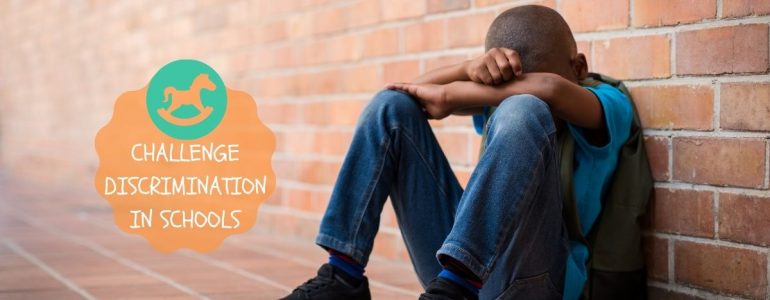The UK schools are a great big melting pot of children from different cultures, areas, religions and lifestyles. Some might think that this is the ideal way to introduce mixing with other kids and the best way to experience different lives – but actually it can be one of the hardest places to avoid discrimination.
Kids can be excessively cruel, especially if they decide that someone is different – school can be, sadly, the prime suspect in discrimination starting early and being embedded in young minds from very early on.
If a school has a good discrimination policy and the teachers are inclusive of everyone, then discrimination has less of a chance – but sometimes even the adults need educating. Here’s how to challenge discrimination in schools & more.
What is discrimination in schools?

Discrimination in schools is the same as discrimination anywhere else – it is the treating of an individual less favourably than others because of their gender, race, age, disability or religious beliefs.
There are two types of discrimination – direct and indirect:
- Direct discrimination is where a child is treated differently because of how they look, what they believe, or whether they are a boy or a girl.
- Indirect discrimination is where a policy or a rule is applied that puts someone at a disadvantage compared with others.
Both types of discrimination are completely outlawed at schools, and should be challenged if they are ever apparent.
Discrimination can happen to anyone in schools, whether teachers or students, and it must be dealt with swiftly if it ever rears its ugly head.
How to recognise discrimination
Discrimination can be types of bullying such as name calling, physical abuse or mental abuse. It can also be treating someone differently because of differences or perceived differences.
Creating laws or policies that adversely affect large groups of people with the same characteristics is discriminatory, as is refusing to remove barriers for disabled people.
Have a read of the Equality Act and the Human Rights Act, so that you know what your rights are and what is acceptable and not.
This will also help you to understand the different types of discrimination and what might be affecting you or your children, and help you find different ways to deal with the challenges you or your children are facing.
How to challenge discrimination in schools?
School is one of the places where discrimination of any form is absolutely not allowed, ever. All children deserve the chance to receive an education, without feeling uncomfortable or threatened because of their race, gender, disabilities or religion.
If you suspect that your child – or any child, for that matter – is being discriminated against in school, then there are a lot of things you can do to sort the issues out.
- Raise any issues with the school. Take your concerns first to your child’s teacher, and continue to the head if necessary. The vast majority of schools are open to discussion, so a chat should be your starting point.
- Write letters to the governing bodies. Getting in touch with local authorities, if your worries are not being listened to by the school, will help take matters further.
- Do your homework. Have a read of the Equality Act 2010, to make reasonably sure that discrimination has taken place, and work out where you stand on complaining about it.
- Suggest diversity training. If a school’s policies on discrimination are not up to date, there is no chance for the teachers to help the children accept each other, so suggesting further training can benefit everyone.
- Make sure your child is accepting of others. Education starts at home, so talking to and teaching your children to be kind to other people and to not discriminate due to skin colour, gender or different religious beliefs, will help others to be more accepting too.
What to do about discrimination in schools
- The first step is to identify who, or what, is discriminating against your child. Then you need to find out why, and what form the discrimination takes.
- In most cases, any problems you have can be solved through informal channels, so start by simply talking.
- Begin by talking to your child’s teacher, or even the head teacher, but if you find your concerns are not allayed then you can take the matter further.
- Most schools will have their own complaints procedure, so you can go through this to get your problems sorted.
- If this does not solve the matter, especially if it very serious or ongoing discrimination then you can go even higher up, and take your complaint to court – though you will need to lodge your claim within 6 months of the original event for it to be valid.
Final words
Discrimination in any form is unacceptable in this day and age. If you suspect your child is being discriminated against – or if you are a teacher in a school and you think there is discrimination in your working environment, they key is to sort it out as quickly as possible.
Start with informal talking, as it is very possibly a misunderstanding or a problem that can be easily solved, then take your complaint further if a simple chat cannot fix the problem.
Discrimination is a serious problem, and you will have right on your side if you decide to challenge it. And remember, you should always challenge discrimination wherever you see it.









